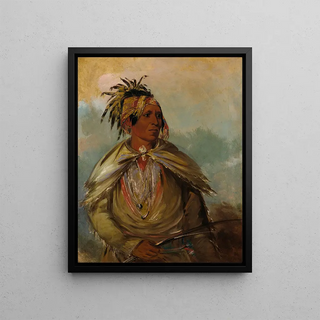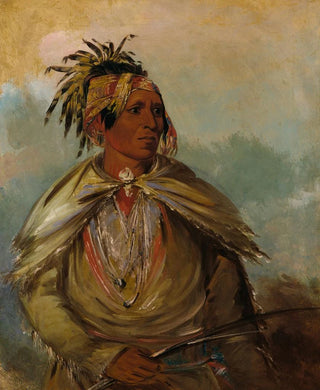Art print | Pah-mee-cw-ee-tah L'homme qui traque un chef - George Catlin


View from behind

Frame (optional)
The artwork "Pah-mee-cw-ee-tah L'homme qui traque un chef" by George Catlin is set within a rich historical and cultural context, revealing the dynamics between indigenous peoples and European colonizers. This striking depiction of a hunter engaged in a chase symbolizes not only the skill and bravery of Native American tribes but also the tensions that existed at that time. Catlin, through his perspective as an artist and observer, immerses us in the fascinating world of indigenous cultures, while also bearing witness to their fragility in the face of colonial expansion. The art print of this piece allows appreciation of the depth of this frozen moment in time, while paying tribute to a often overlooked heritage.
Style and uniqueness of the work
This piece stands out for its striking realism, characteristic of Catlin's style. The artist, a true chronicler of his era, manages to capture not only the physical appearance of his subjects but also the very essence of their existence. The vibrant colors and meticulous details of the scene create an immersive atmosphere, inviting the viewer to feel the palpable tension of the chase. The figures are rendered with such precision that they almost seem to come to life, revealing the emotions and motivations of the characters depicted. This unique style, combining a keen sense of observation with refined aesthetics, makes this work a masterpiece of American artistic heritage.
The artist and his influence
George Catlin, born in 1796, was a pioneer in the representation of Native American cultures through art. His passion for these peoples led him to travel across the United States, documenting their ways of life, traditions, and environment. Catlin was not only a talented artist but also a passionate advocate for the rights of indigenous peoples, seeking to raise public awareness of the challenges they faced. His work has had a lasting impact on art and history, inspiring many artists and researchers to explore themes of identity and culture. The art print of "Pah-mee-cw-ee-tah L'homme qui traque un chef" bears witness to this enduring legacy.

Matte finish

View from behind

Frame (optional)
The artwork "Pah-mee-cw-ee-tah L'homme qui traque un chef" by George Catlin is set within a rich historical and cultural context, revealing the dynamics between indigenous peoples and European colonizers. This striking depiction of a hunter engaged in a chase symbolizes not only the skill and bravery of Native American tribes but also the tensions that existed at that time. Catlin, through his perspective as an artist and observer, immerses us in the fascinating world of indigenous cultures, while also bearing witness to their fragility in the face of colonial expansion. The art print of this piece allows appreciation of the depth of this frozen moment in time, while paying tribute to a often overlooked heritage.
Style and uniqueness of the work
This piece stands out for its striking realism, characteristic of Catlin's style. The artist, a true chronicler of his era, manages to capture not only the physical appearance of his subjects but also the very essence of their existence. The vibrant colors and meticulous details of the scene create an immersive atmosphere, inviting the viewer to feel the palpable tension of the chase. The figures are rendered with such precision that they almost seem to come to life, revealing the emotions and motivations of the characters depicted. This unique style, combining a keen sense of observation with refined aesthetics, makes this work a masterpiece of American artistic heritage.
The artist and his influence
George Catlin, born in 1796, was a pioneer in the representation of Native American cultures through art. His passion for these peoples led him to travel across the United States, documenting their ways of life, traditions, and environment. Catlin was not only a talented artist but also a passionate advocate for the rights of indigenous peoples, seeking to raise public awareness of the challenges they faced. His work has had a lasting impact on art and history, inspiring many artists and researchers to explore themes of identity and culture. The art print of "Pah-mee-cw-ee-tah L'homme qui traque un chef" bears witness to this enduring legacy.






